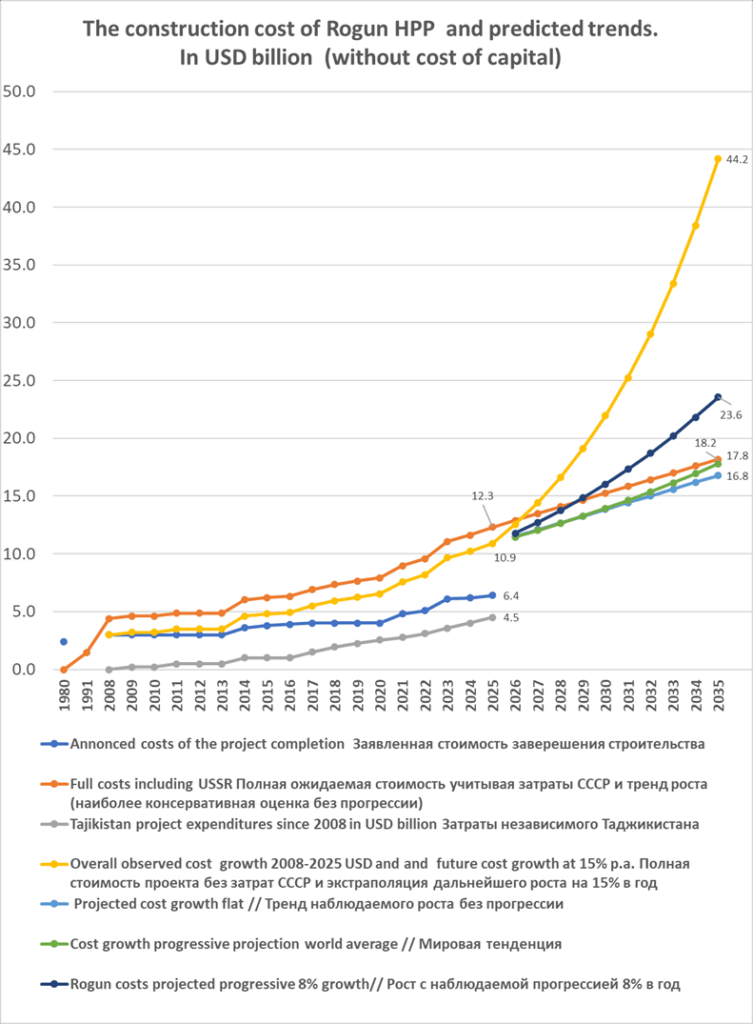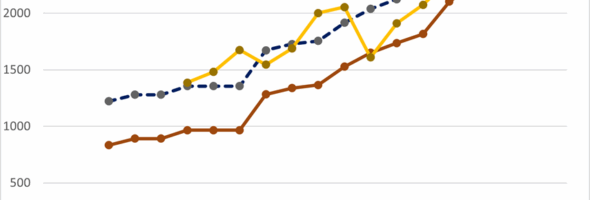According to the press service of the President of the Republic of Tajikistan, for construction of the Rogun Dam 4.3 billion somoni ($451 million) have been allocated from the state budget since the beginning of 2025.
Based on newly available data, the RwB reevaluated the estimated construction costs and future projections as of the planned completion date.
Current Situation
If expenditures in 2025 are limited to USD 451 million, the overall construction costs incurred since 2008 will total USD 4.5 billion. USD 1.4 billion was previously spent on the project by the USSR (figures adjusted for inflation). Therefore, the total construction costs incurred are slightly below USD 6 billion.
Available estimates from the Rogun Project are not trustworthy. For example, despite the completion of the Environmental and Social Management Plan (ESMP), the overall budget for the next seven years consists of $275 million for environmental officials’ salaries and a mere $36 million for specific on-the-ground activities. Taken together, this is still less than 5% of the project completion costs, which the IMF estimates at 6.4 billion USD. The resettlement action plan budget for 45,000 to 55,000 people is estimated at $287 million to $330 million, or another 5% of the project completion costs. The expected negative impacts of the Rogun HPP are substantial, yet the environmental and social expenses are poorly planned and insufficient to mitigate those impacts. These environmental and social costs constitute only 5% of the project’s total expected costs, which may indicate a lack of ESG standards. According to our analysis of the recently released Resettlement Plan, the people currently being resettled receive less than USD 1,000 per person (less than USD 10,000 per household) in compensation for their dwellings. This amount is insufficient to build new houses and restore their livelihoods.
Initially, the RwB expected that the anticipated full costs of project completion would increase substantially during the finalization of the ESIA and ESPM under the supervision of international banks, in line with the need to properly implement environmental and social safeguards. We have yet to investigate why the planned E&S expenses remained at such low levels.
For now, we know that the estimated construction cost of the Rogun HPP Project in August 2025 is USD 10.9 billion, or USD 12.3 billion if USSR expenses are considered. The World Bank estimates Tajikistan’s GDP in 2024 to be USD 14.2 billion, nearly equal to the full cost of this project alone.
Future cost overruns
Underestimation of construction costs and subsequent cost overruns are a widely known and practically inevitable phenomenon in large dam construction.
When Tajikistan’s government revived the Rogun construction project in 2008, its projected full construction cost was USD 3-4.4 billion, which more than tripled by 2025. Thus, the expected full cost has increased by an average of 15% per year over the last 17 years.
Construction is currently expected to be completed by the end of 2035, which is ten years from now. Applying the same expected growth rate of 15% predicts full construction costs of an astonishing USD 44 billion. Let us assume that this figure is the highest possible estimate, which (hopefully) has an extremely low probability of occurring. (Scenario A)

When we examined the cost of the Rogun hydropower project’s construction per unit of capacity, we discovered that it has grown from USD 833 to USD 2,888 since 2008. Over the last 10 years, these costs have increased by 8% annually. If we extrapolate this growth rate for the next 10 years, the full construction cost will reach USD 23.6 billion by 2035 (or USD 25 billion if we take the USSR expenses into account). This would double the project’s current estimated costs and be similar to the cost overruns of many other large hydropower projects in the past. (Scenario B)
If we substitute the Rogun-specific rate of cost increase (8%) with the average rate of installed cost increase in global hydropower during the last decade, as reported by the International Renewable Energy Agency (IRENA) (5%), the total cost at completion would be USD 17.8 billion, or USD 19.2 billion with the USSR expenses. (Scenario C)
If we decide not to use any progression and simply add the annual average increase in cost per kilowatt installed (155 USD), the full construction cost in 2035 would be 16.8 billion USD, or 18.2 billion USD with the USSR expenses. (Scenario D)
All of these calculations were made without considering the cost of capital, which could add 20-25% to the price tag of the Rogun HPP.
We cannot predict the actual cost of Rogun construction with greater certainty, while the date of dam completion is also highly uncertain.
However, it is highly likely that Scenario D underestimates the future increase, while Scenario A grossly overestimates the final construction cost (assuming that international financial institutions have the means to control and limit corruption).
None of our scenarios seem to align more closely with reality, than the publicly available World Bank documentation, which never analyzed the project’s viability under realistic cost overrun scenarios during sensitivity analysis.
Although our scenarios may seem simplistic, they are more realistic than the World Bank’s publicly available documentation. The World Bank never disclosed an analysis of this project’s viability under realistic cost overrun scenarios during sensitivity analysis.

Comparing alternatives
According to IRENA, the full installed cost of solar PV will be less than USD 400/kW by 2029 (compared with USD 691 in 2024). If the $12 billion yet to be invested in the completion of the Rogun HPP (Scenario D) were instead used to build solar farms at 2029 prices, those funds would be sufficient to develop over 30 GW of electricity generation capacity in Central Asia. Meanwhile, the maximum capacity of the Rogun HPP is 3.78 GW.
Despite continuous requests from NGOs, the Tajikistan government and the World Bank refused to perform a valid assessment of the alternatives and compare the current megadam plan with other scenarios that envision a lower dam and the development of solar and wind farms.
Now, as a dozen international financial institutions succumb to demands to finance the completion of this 50-year-old megaproject, it is important to understand the likely consequences and hold the irresponsible officials accountable for decisions that will ruin the future.


